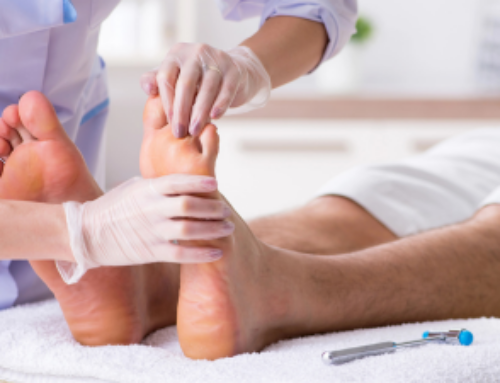Many people experience heel pain after exercising. It can range from mild soreness to stabbing pain and is often the result of faulty biomechanics, excess weight, or an injury. While placing too much stress on the heel and surrounding tissues can result in pain, inactivity can also lead to tight muscles and stiff joints.
The foot and ankle contain 26 bones—including the heel—33 joints, and more than 100 tendons. According to the American Academy of Orthopedic Surgeons, when it comes to exercise, activities such as running can cause an impact on your feet that is equivalent to three times your body weight. With that much pressure, it’s no wonder that runners and other athletes often suffer from heel pain.
Heel pain associated with exercise has a number of common causes:
- Plantar fasciitis occurs when too much pressure is placed on your feet, which can damage the plantar fascia ligament and cause pain and stiffness. Wearing shoes that offer poor support can cause arch pain in your foot and increase your risk of developing plantar fasciitis.
- Stress fractures are tiny cracks in a bone and often occur in the bones of the lower leg and foot. They are usually caused by overuse and repetitive activity, such running, soccer, or basketball.
- Achilles tendonitis is a condition that occurs when the tendon that runs down the back of the lower leg becomes inflamed. It is often caused by overuse, injury, or repetitive stress to the tendon.
- Foot sprain can occur when you stretch or tear the ligaments that connect the bones of the foot. Symptoms include pain and swelling, bruising, and walking with a limp.
- Heel spurs are abnormal growths of extra bone that develop between your heel bone and arch when the body tries to repair a problem by building extra bone. Symptoms include pain, inflammation, and swelling at the front of your heel.
- Bursitis is a painful condition that affects the small, fluid-filled sacs (called bursae) that act as cushions between your bones. Repetitive motion, including running and jumping, is a common cause of the condition.
How to reduce heel pain associated with exercise
-
Stretch before and after you exercise
Stretches that can help prevent exercise-related heel pain include:
Calf stretch. Stand with your palms flat against a wall at chest level. Set one foot back several inches, keeping your knee locked, and move toward the wall without lifting your heel. Hold the stretch for ten seconds, and then relax. Do at least three sets on each leg.
Towel stretch. Sit on the floor with your legs extended and feet straight in front of you. Loop a towel around one foot just under the toes. Hold the ends of the towel in your hands, pull back until your foot stretches toward you, and hold the position for up to 30 seconds. Do this at least three times with each foot.
Water bottle exercise. Place a frozen water bottle on the floor sideways and slowly roll it back and forth under the sole of your foot as you sit in a chair. In addition to massaging the plantar fascia, ice can help decrease swelling and inflammation. Continue for no more than 15 minutes, as prolonged exposure to ice can lead to frostbite.
Plantar fascia stretch. In a seated position, cross one foot over the knee of your other leg. Grab your big toe and slowly pull it toward you in a controlled fashion for 15 to 30 seconds. Repeat the stretch three times on each foot.
-
Take it slow and incorporate breaks into your workout routine
If you haven’t been physically active for a while or are new to exercise, it’s important to listen to your body and get plenty of rest. Gradually, you will be able to increase your workout intensity as you pursue your goal of living a more active life.
-
Wear appropriate athletic shoes when you exercise
To improve your comfort and help prevent injuries, wear proper athletic shoes for exercise. Activities such as running and jumping put excessive pressure on the feet, ankles, and legs. As you look for shoes, make sure they are sturdy, offer good arch support, and include a cushioned heel.
-
Wear custom orthotics to prevent heel pain
Finding the right shoe for your foot is essential, but wearing custom orthotics for foot health can help prevent injuries from high-impact activities such as running and jumping. Custom orthotics help balance the foot and can improve your athletic performance.
-
Soak your feet
Soaking your feet in warm water after you exercise can help reduce inflammation and heel pain. Many people find that adding Epsom salt (or magnesium sulfate) soothes sore muscles after a workout. If you choose to soak your feet in an ice bath, do so for no more than 15 minutes.
-
Incorporate time for recovery into your workout plan
It’s crucial to allow your body to recover between training sessions, particularly if you suffer from heel pain. In general, 24 to 48 hours of rest between sessions for the same muscle group gives your body the time it needs for muscle recovery.
When to see a doctor for heel pain
While these tips can help reduce heel pain, be sure to stop exercising if your pain is severe. Continuing to engage in physical activity after an injury can worsen your symptoms and lead to permanent damage.
Long-term or chronic pain may be a sign of a serious injury or undiagnosed condition. The board-certified professionals at Metro Tulsa Foot & Ankle Specialists are trained to provide a diagnosis and help you find relief from heel pain.
Schedule an appointment today at one of our five convenient locations.
Subscribe to stay up-to-date on news and tips from us.





